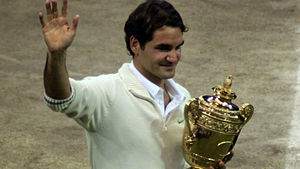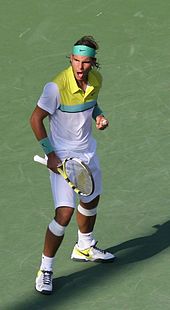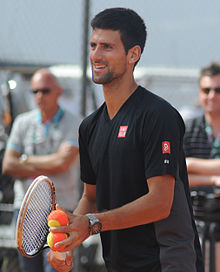The joy of tennis
Subscribe here (it's free!)
Asterisks are explained at the bottom.
Intro
Sports - activities where people try to prove they are better than others at an activity they wouldn’t be caught dead doing otherwise. Outside the world of sports, it would be ludicrous to find 11 people running behind a ball, but say you can do it better than any other set of 11 people, and the world will throw millions at you. While they might seem stupid if you try thinking about the higher purpose in the purpose of sports, you would be hard pressed to find someone not tuning in for the big final. Not sure why that is. Maybe it’s the privilege of getting to see two masters battle it out to prove themselves. Or maybe it’s the vicarious wave of victory that sweeps over you when the underdog comes out on top. Or maybe it is the mawkish mess you find yourself reduced to when your team or your player finally wins that coveted trophy. Or maybe it’s something else all together.
Over the past few years, tennis has - for me - superseded all other sports in viewing pleasure. The meditative quality of the periodic nature of the game aside, in the last few years, tennis has been feted with a fantastic story as well. And while your favourite TV shows may have you hypnotized for a few seasons, the world of tennis has produced joy, disappointment, bitterness and rage for years. It wasn’t always like this, though.
Back in the late 90s, tennis was one of two sports that dominated the screen at home. A young Martina Hingis topped the WTA charts while Sampras and Agassi went toe-to-toe on the men’s side. Tennis was fun, but in the race for viewership, it took a clear second place behind the masochistic viewings of the many failures of the Indian cricket team. The next few years passed without much fuss, with several players in the limelight for short periods of time. The tennis world was reeling from the void created by Sampras’ retirement. The lack of a star to carry it did not bode well. Players cycled through the top spots - taking and vacating them in quick succession. Tennis seemed boring, quietly belying the spectacle it was about to become.
The protagonist
Roger Federer

Our journey begins around 2008, when a Swiss going by the name of Roger Federer, was laying waste to anyone on the tennis court not named Roger Federer. The rest of the tour* languished in the destruction Federer left in his wake. Pardon me, for it would not be right for me to use the term destruction to describe Federer’s triumphs. His methods were not violent in the least. He sliced through his opponents not with brute force, but with effortless adroitness. A few surgical cuts here and there, slowly but surely, bleeding his opponents dry as he reduced them to spectators of a masterclass. His challengers were challengers only in name, and his dominance meant that their spirit was vanquished long before the first ball was hit.
From 2004-2007, Federer dominated the world of tennis like few had done before. Of the 16 Grand Slams* on offer, Federer won 11. To put this into perspective, at the time, only 4 men had won 11+ Grand Slams in their entire careers. He had made the past 10 Grand Slam finals, losing just two. He held a firm grip on the World #1 spot, and would go on to break the records for most weeks at #1 and most consecutive weeks at #1. With such sheer dominance, surely there was no question that Federer was the undisputed best of all time? Surprisingly, he may not even have been the best of his time.
The antihero
Rafael Nadal

The second character of our story - a supporting act, but possibly the best supporting act ever played.
Rafa Nadal, a Spanish teen hailing from Mallorca, played the game distinctively different to the way Federer did. While Federer glided across the court, caressing the ball in silence; Rafa ran doggedly and bludgeoned his forehands, grunting louder with every shot. Federer played right-handed and preferred an attacking game, aided by a great serve; Rafa played left-handed, had an average serve and preferred to defend. Federer was lauded for his class; Nadal was chided for his peculiar plebeian habit of picking at his underwear. Federer was fluent in a number of languages whereas Rafa stuck to Spanish. For both Federer’s records at the #1 spot, it is likely that Nadal held the corresponding records for the #2 spot*.
While all the other players on the tour meekly surrendered to Federer, Nadal was slowly carving out a piece of clay in Federer’s kingdom. A piece that he staunchly refused to yield. Remember the only two Grand Slam finals that Federer lost in the last two years? Both were lost on clay to Rafa. In what can only be considered an affront to the story’s lead character, Nadal had kept and held the only piece of silverware Federer needed to complete a Career Grand Slam. To add to Federer’s frustration, Nadal had won the French Open thrice by 2007 and seemed unbeatable on clay. Despite being five years his junior, Nadal was yet to lose a single match at the French Open.
While Federer’s kingdom was massive - he was an all-court player after all - his castle was surely on the grass at Wimbledon. Wimbledon was Federer’s Grand Slam. Playing on those quick courts in England boosted his game to another level, evidenced by his five-year winning streak at the event. He had not lost a match at Wimbledon since 2002.
As we continue our story at the start of 2008, we are forced to pause for a bit to introduce our third character,
The comic relief
Novak Djokovic

At the first slam of the year - the Australian Open - another routine Federer win looked to be on the cards. Nadal was yet to make the semifinals at the Australian Open, and these two were head and shoulders above the rest of the field. Another player had established himself in the #3 spot as firmly as Federer and Nadal had in spots #1 and #2. Enter Novak Djokovic, a Serbian of Nadal’s age known for his jocular impressions of other tennis stars. Nicknamed “The Djoker”, an unassuming Djokovic coasted against than the rest of the tour, but stayed a clear second-best to Federer and Nadal. Out of the blue, Novak upsets Federer in one semifinal (Nadal lost in the other) and goes on to win the trophy. Surely, his win was just an anomaly? Indeed, it was the only final from 2005-2010 that would not feature either Nadal or Federer. Rafa and Federer got straight to setting the tennis world in order by contesting the next few Masters finals.*
The Battle - Part 1
The first half of the battle between Nadal and Federer would take place on the clay in Paris. Nadal had beaten Federer en route to all his French Open titles. It was very likely that they would face off in the final again. Would Federer be able to breach Nadal’s fortress on clay?
Not if Nadal had anything to do with it. In the lead up to the French Open, Nadal beat Federer at the Masters tournaments on clay and seemed to be in good shape to retain his trophy. Unsurprisingly by now (for Federer had become the scissors to Nadal’s rock), Nadal handed Federer his walking papers - and in some fashion. Not only did he beat him in straight sets, but to complete the humiliation, he served him a bagel* to munch on. To add the figurative cherry on what was definitively Nadal’s French Open cake, he won the tournament without dropping a set.
The Battle - Part 2
With the battle on his turf settled, now it was Nadal’s turn to see if he could usurp Federer’s throne. Nadal and Federer had met in the past two Wimbledon finals. Nadal had been bageled by Federer two years ago, but had pushed him to five sets last Wimbledon. Nadal was clearly a better player than he was a year ago and with the Roland Garros win(d) beneath his wings, he made the Wimbledon final. Waiting for him, as always, was Mr. Roger Federer. And so, the stage was set. Would the 2008 Wimbledon tournament signify the crowning of a new king? Or would Federer survive - possibly to go on to stamp out this unwanted asterisk on his reign at next year’s French Open? Millions tuned in.
The final had been hyped tremendously with everyone’s expectations set higher than was healthy. As the match played out, it became very clear that this match would be one for the ages. The shots were hit with tremendous power and otherworldly accuracy. Both players pushed themselves to the limit and then, they pushed the limits. Balls kissed the lines time and again as Federer and Nadal staked claim to the green grass of Wimbledon. As a neutral, all I wanted was that the match go to five sets. I wanted the magic to go on as long as humanly possible. I wanted this gift to keep on giving.
As Federer’s forehand caught the net, and Nadal fell to the ground, an era ended. The king is dead, long live the king! Nadal had dethroned Federer in his kingdom, in his house. For the first time since Bjorn Borg, a master of the red clay in France stood victorious on the green grass in England. It only seemed like a matter of time before Nadal ruled the world of tennis like his fallen colleague once did.
The aftermath
Nadal continued in the same vein, proceeding to complete the takeover in August, when he exiled Federer from the No. 1 spot. The No. 1 spot that had been Federer’s home for over four years now. To see someone else occupying it lent a certain uneasiness to the viewer. However, with Nadal going on to win the Olympic gold as well, it seemed certain he’d be here to stay.
Federer wasn’t done yet, though. He may have come up short (time and again) against Nadal, but as long as someone else beat Nadal, Federer was in with a shot. Federer and Nadal traded the next few slams between themselves. Combined, Federer and Nadal won 7 of the 8 slams in 2009 and 2010. Notably, Federer finally completed his Career Grand Slam in 2009. Nadal won the Australian Open in 2009 to go with the French and Wimbledon he already held, and after being upset in the French in 2009, he returned with a bang at Roland Garros in 2010, winning the tournament without dropping a set. By winning the last three Grand Slams of 2010, he won three Grand Slams in a year on three different surfaces - something Federer had not done before. In fact, no one except Rafa Nadal has ever done that.
It looked like the tide had completely turned in Nadal’s favour by the end of 2010. While Federer completed his Career Grand Slam by winning the French Open in 2009, he had not beaten Nadal in a Grand Slam other than Wimbledon, and he had never beaten Nadal in a slam after 2007. On the other hand, Nadal had beaten Federer in the finals of every slam except US Open (where they haven’t met in any round till today). Slowly, but surely, this was becoming Nadal’s era. But, wasn’t he only supposed to be a supporting act?
The protagonist?
Novak Djokovic, Act 2
2011 changed everything. Remember Novak Djokovic? The guy who won that one Australian Open back in 2008? No one’s sure what he changed (was it the gluten-free diet or just mental strength?), but he invited himself to the Grand Slam party in a big way. Djokovic had been making deep runs into the slams for a couple of years now, but - like the rest of the tour - threatened neither Rafa nor Federer at the Slams. By the time the French Open rolled around, our story had changed quite a bit. Djokovic had taken the Australian Open and had established himself as the player to beat. He had not lost a single match since the start of the year and had built up this crazy winning streak while playing against two of the greatest players to lay their hands on a tennis racket.
The rivalry to watch had changed from Federer-Nadal to Nadal-Djokovic. Their matches were long hard-fought battles of attrition that allowed only for a pyrrhic victory. Back in Nadal’s court, Djokovic was no longer the court jester. En route to the French Open, Djokovic had beaten Nadal twice in clay finals. The writing was on the wall. Unbeaten to this point, Djokovic suffered his first loss of the year to none other than a certain Swiss. Turns out Roger Federer was not quite done yet. Of course, he capitulated in the final to Nadal, but, by ending Djokovic’s streak, Federer reminded everyone that there existed a triumvirate at the top. Not in the least affected, Djokovic brushed off the French Open loss and picked up right where he left off. He won the next two slams, beating supposed king Nadal in both finals. By the time the last slam of the year ended, Djokovic had three slams to his name and only two losses. His record against Nadal and Federer that year? 10 wins and only that solitary loss to Federer.
I said HEY, what’s going on?
The 2012-2014 period was chaotic. Although Djokovic held the no. 1 spot for large periods, he also lost it to Federer (for a few months in 2012) and Nadal (for a year starting 2013). Djokovic’s results at the Masters tournaments were stellar, but he failed to convert the success to Grand Slam wins. He lost Grand Slams to Murray, who had never beaten Federer or Nadal in a Grand Slam final. While Djokovic was #1, he was neither as good nor as successful as he was in 2011. He collected as many slams in those three years as he did in 2011 alone. 2013 in particular was weird. Federer seemed to be waning quickly and Nadal - returning from injury - went on a great run to win the US Open, thus denying Djokovic another Slam. 2014 compounded the weirdness that 2011 provided and despite the trio finding form, we were treated to two unexpected first-time Grand Slam winners (Wawrinka and Cilic).
In short, the tennis world was going off script.
Where are they now?
As of 2015, it looks like the tennis world may be getting some of its consistency back. Djokovic has settled well in the top spot and claimed three Grand Slams this year (making the finals of the fourth). He also became the first man to win the first three Masters tournaments of the year and is guaranteed to end the year as #1. Despite being denied the Career Grand Slam (by that man Wawrinka), Djokovic has had a stellar year.
Astonishingly, old man Roger Federer (now 34) has been playing at a sublime level. He contested two Grand Slam finals against Djokovic (losing both) and has added a new weapon (SABR - Sneak Attack By Roger) to his already bursting arsenal. He is currently #2 in the rankings, and of his eight losses this year, four were against Djokovic.
Sadly, Nadal has had a horrendous year - easily his worst. He lost in the French Open and the only thing shocking about the loss, was that it was not in the least bit shocking. He not only failed to win the French Open, he also failed to win a single Masters event on clay for the first time in his career. His famed fortress on clay was naught but rubble. He fell out of the top ten and failed to win a Slam for the first time in ten years. Nadal’s last Slam match for the year was in the US Open against Fabio Fognini, an Italian he had not lost to in five matches before 2015. That US Open match was his third loss of the year to Fognini.
Tennis now awaits a new challenger and with it, a new story.
Appendix
*The four Grand Slams each year are the biggest tournaments in tennis. The Australian Open, the French Open, Wimbledon and the US Open. They are each challenging in their own unique way primarily because of the surface they are played on but also because of the crowds and the atmosphere. The Australian Open and the US Open are played on hard courts, the French is played on clay while Wimbledon, arguably the most prestigious of the slams, is played on grass. The travel time and costs to Australia deterred many players from participating in the Australian Open till the early 90s. Winning all four Grand Slams in a year constitutes winning the Calendar Grand Slam. Winning all four over the course of a career is called the Career Grand Slam.
*Although I laboured to find the record for most weeks at #2, I was unsuccessful.
*The rest of the tour: The rest of the players on the tour. A common shorthand.
*Bagel: (v) to bagel someone. Winning a set 6-0. A humiliating way to lose a set. Winning two sets (or three for men’s Grand Slams and World Tour Finals) wins you the match.
*Masters tournament: Tournaments that are only below Grand Slams and the World Tour Finals in order of prestige and points.